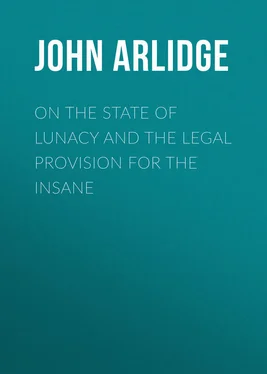John Arlidge - On the State of Lunacy and the Legal Provision for the Insane
Здесь есть возможность читать онлайн «John Arlidge - On the State of Lunacy and the Legal Provision for the Insane» — ознакомительный отрывок электронной книги совершенно бесплатно, а после прочтения отрывка купить полную версию. В некоторых случаях можно слушать аудио, скачать через торрент в формате fb2 и присутствует краткое содержание. ISBN: , Жанр: foreign_antique, foreign_prose, на английском языке. Описание произведения, (предисловие) а так же отзывы посетителей доступны на портале библиотеки ЛибКат.
- Название:On the State of Lunacy and the Legal Provision for the Insane
- Автор:
- Жанр:
- Год:неизвестен
- ISBN:http://www.gutenberg.org/ebooks/44320
- Рейтинг книги:3 / 5. Голосов: 1
-
Избранное:Добавить в избранное
- Отзывы:
-
Ваша оценка:
- 60
- 1
- 2
- 3
- 4
- 5
On the State of Lunacy and the Legal Provision for the Insane: краткое содержание, описание и аннотация
Предлагаем к чтению аннотацию, описание, краткое содержание или предисловие (зависит от того, что написал сам автор книги «On the State of Lunacy and the Legal Provision for the Insane»). Если вы не нашли необходимую информацию о книге — напишите в комментариях, мы постараемся отыскать её.
On the State of Lunacy and the Legal Provision for the Insane — читать онлайн ознакомительный отрывок
Ниже представлен текст книги, разбитый по страницам. Система сохранения места последней прочитанной страницы, позволяет с удобством читать онлайн бесплатно книгу «On the State of Lunacy and the Legal Provision for the Insane», без необходимости каждый раз заново искать на чём Вы остановились. Поставьте закладку, и сможете в любой момент перейти на страницу, на которой закончили чтение.
Интервал:
Закладка:
On the other hand, the consequences of the variations in asylum accommodation upon the total of admissions are to a certain extent compensated for by the fluctuations they produce upon the number of lunatics not provided for in asylums; for this reason, that where a County Asylum opens for the reception of patients, the majority of these are withdrawn from Licensed Houses and workhouses, and thereby a reduction is effected in the number of inmates of those establishments.
After the above considerations, it is clear that an estimate of the number of insane persons in any year, as gathered from the statistics of those brought under treatment in asylums or elsewhere, can be only an approach to the truth. Still it is worth while to see what results follow from an examination of the Returns of Admissions, as collected by the Commissioners in Lunacy. It would be of no service to extend the inquiry far backward in time, on account of the rapidity with which asylum accommodation has been enlarged; we will therefore compare the admissions over the space of four years, viz. 1854, 1855, 1856, and 1857, during which the changes in asylums have been less considerable.
Table of Admissions.

There is a remarkable degree of uniformity in the sum of admissions in each of these four years; and if each several sum could be taken to represent the accession of new cases of insanity in the course of the year, there would appear no actual progressive increase of the disease in the community during the four years considered. The average of the admissions for that period is 7579; those therefore of 1854 and 1857 are in excess, and those of 1855 and 1856 are within it. The widest difference is observed in 1857, when a sudden rise takes place, which, by the way, is not explicable by the greater provision of asylum accommodation in that year than in the three preceding. Yet this increase is not so striking when viewed in relation to the totals of other years; for it exceeds the average only by 316, a sum little greater than that expressing the decrease of 1855 upon the total of 1854.
It is difficult to decide what value should be assigned to these results, deducible from a comparison of the yearly admissions, in determining the question of the increase of insanity, viewed simply as that of the comparative number attacked year by year, – it would, however, seem a not unreasonable deduction from them, that the proportion of persons attacked by mental disorder advances annually at a rate little above what the progressive increase of population is sufficient to explain. If this be so, the increase by accumulation of chronic and incurable cases becomes so much the more remarkable, and an investigation of the circumstances promoting, and of those tending to lessen, that accumulation, so much the more important.
There are, as heretofore remarked, very many insane persons who are not sent to asylums or private houses, at least to those in this country, and whose relative number yearly it is impossible, in the absence of all specific information, to compute. Although the agitation of the public mind respecting private asylums, and the facility and economy of removing insane persons abroad, may have latterly multiplied the number of such unregistered patients, yet there is no reason to assume that their yearly positive increase is other than very small.
The pauper lunatics living in workhouses have as yet been omitted from the present inquiry. Their yearly number is affected not only by the introduction of fresh cases, but also by removals to asylums and by deaths; or, in other words, it is a compound quantity of new inmates received and of the accumulation of old. However, the returns above quoted (p. 13) show that between 1855 and 1858 there was an increase of almost exactly 1000, or, as before calculated, an average of 329 annually. The Poor Law Board Report unfortunately gives no returns of the annual admissions; hence we do not possess the means of discovering what proportion of the growing increase observed is due year by year to the accession of fresh inmates. The advancing growth in numbers of those pauper insane receiving out-door relief is not clearly discoverable: from the few data in possession, as before quoted (p. 14), about 200 are annually added.
It appears pretty clearly, then, that there are at least 1600 reported lunatics added to the insane population of the country yearly, and of this increase only 60, or 1 in 26·66, are supported out of their own resources in asylums; the remainder, with some few exceptions, falling upon the rates for their entire maintenance.
It would therefore be difficult to exaggerate the importance of the question of the provision for the insane poor in this country, both to the political economist and to the legislator. There are certainly more than 1300 persons yearly so affected in mind as to be unfit or unable to take care of themselves, and to obtain their own livelihood, and who, under this distressing infliction of Providence, demand the care and charity of their neighbours, and the succour of the State, properly to protect and provide for them. To perform this duty at the least cost, compatible with justice to these afflicted individuals, involves a tax upon the community of which few persons have any adequate conception. Supposing, by way of illustration, that the number mentioned required the accommodation of an asylum, the cost of providing it, according to the system hitherto in vogue, would nearly equal that incurred in the establishment and maintenance of the Middlesex County Asylum at Colney Hatch, or a sum of £300,000 for land, buildings, and fittings (equal, at 5 per cent. to a yearly rental of £15,000), and an annual charge of £30,000 for maintenance. The example of Colney Hatch, chosen for illustration, is a very fair one, and the figures used in round numbers are actually within the average expenditure in and for the establishment of County Asylums in this country, as may be seen on reference to Appendix D. (Commissioners’ Report, 1854), and to the table of asylums in course of erection, printed at p. 2 of their Twelfth Report (1858).
On applying these results to the total number of pauper lunatics in Asylums, which, according to the return on the 1st of January 1858, amounted to 15,000, the sum of £4,500,000 (not including interest) will have been expended in providing them accommodation, and an annual charge incurred of £450,000 for their care and maintenance. All this, too, is independent of the cost on account of those maintained in Licensed Houses, in workhouses, and in lodgings with friends or others, the amount of which we do not possess sufficient information to determine.
The Commissioners in Lunacy, in their elaborate Report in 1844, took the population of England and Wales at 16,480,082, and reckoned on the existence of 20,893 lunatics on the 1st January of that year, of whom 16,542 were paupers. The latter, they calculated, stood in the proportion of 1 to 1000 in the population, or, more correctly, 1 in 997; and the total lunatics as 1 to 790. On the 1st of January 1857, they found the pauper lunatics to be in the proportion of 1 in 701; whilst pauper and private together equalled 1 in 600, to the estimated population, 19,408,364. Adopting the figures arrived at in the preceding discussion, viz. that there are 41,000 insane persons in this country, and assuming the population on the 1st of January, 1859, to have been 19,800,000, the proportion of the insane would be as high as 1 in 483 persons.
This much-enlarged ratio of insanity to the population admits of several explanations, without a resort to the belief that the disease is actually and fearfully on the increase. As before said, we regard the accumulation of chronic and incurable lunatics to be the chief element in raising the total number, and this accumulation is favoured by all causes operating against the cure of insanity; by the increased attention to the disease, and by all those conditions improving the value of life of the insane, supplied, at the present day, in accordance with the improved views respecting their wants, and the necessity of placing them under conditions favourable for their health, care and protection. On the operation of these causes, favouring the multiplication of insane persons in the community, we shall, however, not at present further enter, but proceed to inquire how far the existing provision for the insane is adequate to their requirements.
Читать дальшеИнтервал:
Закладка:
Похожие книги на «On the State of Lunacy and the Legal Provision for the Insane»
Представляем Вашему вниманию похожие книги на «On the State of Lunacy and the Legal Provision for the Insane» списком для выбора. Мы отобрали схожую по названию и смыслу литературу в надежде предоставить читателям больше вариантов отыскать новые, интересные, ещё непрочитанные произведения.
Обсуждение, отзывы о книге «On the State of Lunacy and the Legal Provision for the Insane» и просто собственные мнения читателей. Оставьте ваши комментарии, напишите, что Вы думаете о произведении, его смысле или главных героях. Укажите что конкретно понравилось, а что нет, и почему Вы так считаете.












